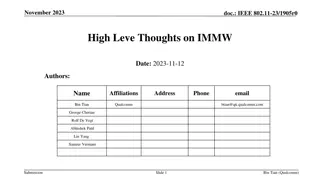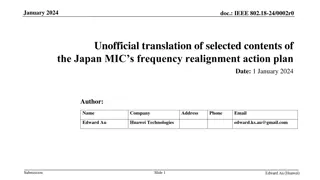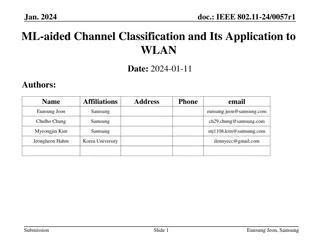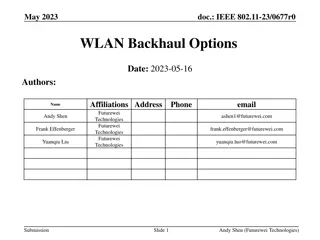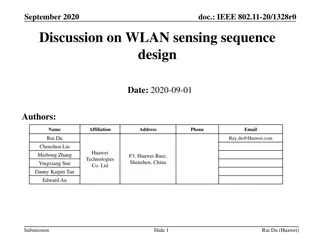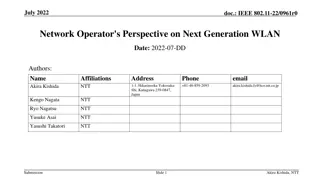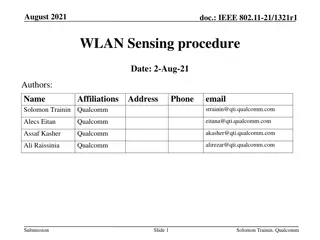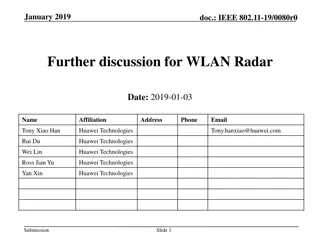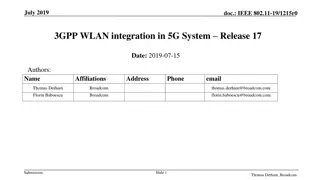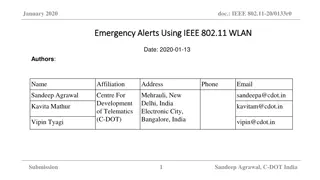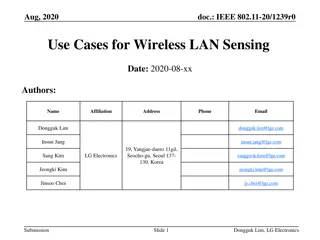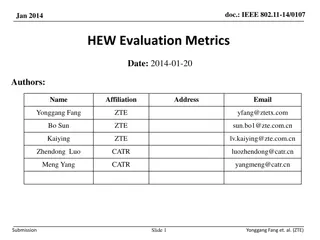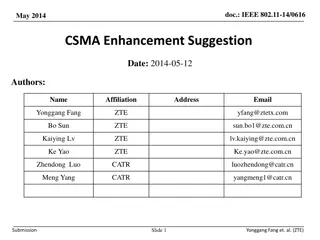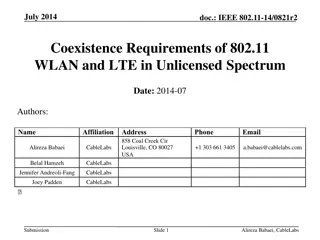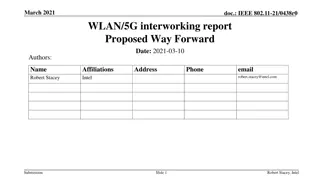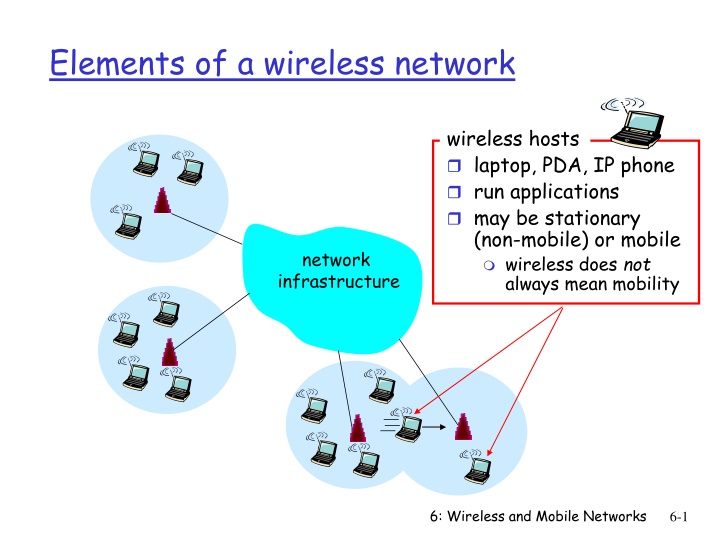
Elements of a Wireless Network and Link Characteristics
Explore the elements of a wireless network including wireless hosts, base stations, and wireless links. Understand the differences between mobile and stationary wireless devices, base stations' role in relaying data between wired and wireless networks, and the characteristics of selected wireless link standards. Learn about infrastructure modes such as handoff and ad hoc mode, as well as the challenges like signal strength attenuation, interference, and multipath propagation in wireless communication.
Download Presentation

Please find below an Image/Link to download the presentation.
The content on the website is provided AS IS for your information and personal use only. It may not be sold, licensed, or shared on other websites without obtaining consent from the author. If you encounter any issues during the download, it is possible that the publisher has removed the file from their server.
You are allowed to download the files provided on this website for personal or commercial use, subject to the condition that they are used lawfully. All files are the property of their respective owners.
The content on the website is provided AS IS for your information and personal use only. It may not be sold, licensed, or shared on other websites without obtaining consent from the author.
E N D
Presentation Transcript
Elements of a wireless network wireless hosts laptop, PDA, IP phone run applications may be stationary (non-mobile) or mobile wireless does not always mean mobility network infrastructure 6: Wireless and Mobile Networks 6-1
Elements of a wireless network base station typically connected to wired network relay - responsible for sending packets between wired network and wireless host(s) in its area e.g., cell towers 802.11 access points network infrastructure 6: Wireless and Mobile Networks 6-2
Elements of a wireless network wireless link typically used to connect mobile(s) to base station also used as backbone link multiple access protocol coordinates link access various data rates, transmission distance network infrastructure 6: Wireless and Mobile Networks 6-3
Characteristics of selected wireless link standards 54 Mbps 802.11{a,g} 5-11 Mbps 802.11b .11 p-to-p link 1 Mbps 802.15 3G UMTS/WCDMA, CDMA2000 384 Kbps 2G IS-95 CDMA, GSM 56 Kbps Outdoor Mid range outdoor Long range outdoor Indoor 50 200m 200m 4Km 5Km 20Km 10 30m New developments 802.11n, up to 4 antenas, up to 600Mbps, about 70m indoor, 250m outdoor range LTE (100 down / 50 up Mbps) WiMax (802.16) (128 down / 56 up Mbps) Note: 802.15 is Bluetooth 6: Wireless and Mobile Networks 6-4
Elements of a wireless network infrastructure mode base station connects mobiles into wired network handoff: mobile changes base station providing connection into wired network network infrastructure 6: Wireless and Mobile Networks 6-5
Elements of a wireless network Ad hoc mode no base stations nodes can only transmit to other nodes within link coverage nodes organize themselves into a network: route among themselves 6: Wireless and Mobile Networks 6-6
Wireless Link Characteristics Differences from wired link . decreased signal strength: radio signal attenuates as it propagates through matter (path loss) interference from other sources: standardized wireless network frequencies (e.g., 2.4 GHz) shared by other devices (e.g., phone); devices (motors) interfere as well multipath propagation: radio signal reflects off objects ground, arriving ad destination at slightly different times . make communication across (even a point to point) wireless link much more difficult 6: Wireless and Mobile Networks 6-7
Wireless network characteristics Multiple wireless senders and receivers create additional problems (beyond multiple access): B A C C C s signal strength A s signal strength B A space Hidden terminal problem B, A hear each other B, C hear each other A, C can not hear each other means A, C unaware of their interference at B Signal fading: B, A hear each other B, C hear each other A, C can not hear each other interferring at B 6: Wireless and Mobile Networks 6-8
IEEE 802.11 Wireless LAN 802.11b 2.4-5 GHz unlicensed radio spectrum up to 11 Mbps direct sequence spread spectrum (DSSS) in physical layer all hosts use same chipping code widely deployed, using base stations 802.11a 5-6 GHz range up to 54 Mbps 802.11g 2.4-5 GHz range up to 54 Mbps All use CSMA/CA for multiple access All have base-station and ad-hoc network versions 6: Wireless and Mobile Networks 6-9
802.11n Evolution of the 802.11a/g Adds: Multiple input multiple output MIMO at the physical layer 40 MHz channels (instead of 20MHz) Frame aggregation at the link layer (multiple Ethernet frames in a single transmission, reduces overhead) Uses both the 2.5 and 5GHz unlicensed spectrum Theoretical max: 600Mbps with 4 MIMO channels. Has been in the standardization process for 12 years (1997 2009), people got impatient (pre-N) devices. 6: Wireless and Mobile Networks 6-10
802.11 LAN architecture wireless host communicates with base station base station = access point (AP) Basic Service Set (BSS) (aka cell ) in infrastructure mode contains: wireless hosts access point (AP): base station ad hoc mode: hosts only Internet hub, switch or router AP BSS 1 AP BSS 2 6: Wireless and Mobile Networks 6-11
802.11: Channels, association 802.11b: 2.4GHz-2.485GHz spectrum divided into 11 channels at different frequencies; 3 non-overlapping AP admin chooses frequency for AP interference possible: channel can be same as that chosen by neighboring AP! host: must associate with an AP scans channels, listening for beacon frames containing AP s name (SSID) and MAC address selects AP to associate with; initiates association protocol may perform authentication [Chapter 8] will typically run DHCP to get IP address in AP s subnet 6: Wireless and Mobile Networks 6-12
IEEE 802.11: multiple access Like Ethernet, uses CSMA: random access carrier sense: don t collide with ongoing transmission Unlike Ethernet: no collision detection transmit all frames to completion acknowledgment because without collision detection, you don t know if your transmission collided or not Why no collision detection? difficult to receive (sense collisions) when transmitting due to weak received signals (fading) can t sense all collisions in any case: hidden terminal, fading Goal: avoid collisions: CSMA/C(ollision)A(voidance) 6: Wireless and Mobile Networks 6-13
Coordination of transmissions Set of rules. Standard allows a number of different behaviors DCF distributed coordinated function (see next slide) Exponential backoff with some specifics PCF point coordination function The access points has priority 6: Wireless and Mobile Networks 6-14
IEEE 802.11 MAC Protocol: CSMA/CA (in DCF mode) 802.11 sender 1 if sense channel idle for DIFS then - transmit entire frame (no CD) 2 if sense channel busy then - start random backoff time - timer counts down while channel idle - transmit when timer expires - if no ACK, increase random backoff interval, repeat 2 802.11 receiver if frame received OK - return ACK after SIFS (ACK needed due to hidden terminal problem) sender receiver DIFS data SIFS ACK 6: Wireless and Mobile Networks 6-15
RTS/CTS idea:allow sender to reserve channel rather than random access of data frames: avoid collisions of long data frames optional; not typically used sender first transmits small request-to-send (RTS) packets to AP using CSMA RTSs may still collide with each other (but they re short) AP broadcasts clear-to-send CTS in response to RTS CTS heard by all nodes sender transmits data frame other stations defer transmissions You can turn this on/off in your WiFi driver. Avoid data frame collisions completely using small reservation packets! 6: Wireless and Mobile Networks 6-16
Collision Avoidance: RTS-CTS exchange B A AP reservation collision DATA (A) defer time 6: Wireless and Mobile Networks 6-17
802.11 frame: addressing 6 4 2 2 6 6 6 2 0 - 2312 frame control durationaddress address 2 address 3 address 4 seq control payload CRC 1 Address 3: used only in ad hoc mode Address 1: MAC address of wireless host or AP to receive this frame Address 3: MAC address of router interface to which AP is attached Address 2: MAC address of wireless host or AP transmitting this frame 6: Wireless and Mobile Networks 6-18
802.11 frame: addressing Internet router H1 R1 AP R1 MAC addr AP MAC addr source address 802.3 frame dest. address AP MAC addr H1 MAC addr R1 MAC addr address 3 address 2 address 1 802.11 frame 6: Wireless and Mobile Networks 6-19
802.11 frame: more frame seq # (for reliable ARQ) duration of reserved transmission time (RTS/CTS) 6 4 2 2 6 6 6 2 0 - 2312 frame control durationaddress address 2 address 3 address 4 seq control payload CRC 1 2 2 4 1 1 1 1 1 1 1 1 Protocol version To AP From AP More frag Power mgt More data Type Subtype Retry WEP Rsvd frame type (RTS, CTS, ACK, data) 6: Wireless and Mobile Networks 6-20
802.11: mobility within same subnet H1 remains in same IP subnet: IP address can remain same switch: which AP is associated with H1? self-learning (Ch. 5): switch will see frame from H1 and remember which switch port can be used to reach H1 router hub or switch BBS 1 AP 1 AP 2 H1 BBS 2 6: Wireless and Mobile Networks 6-21

